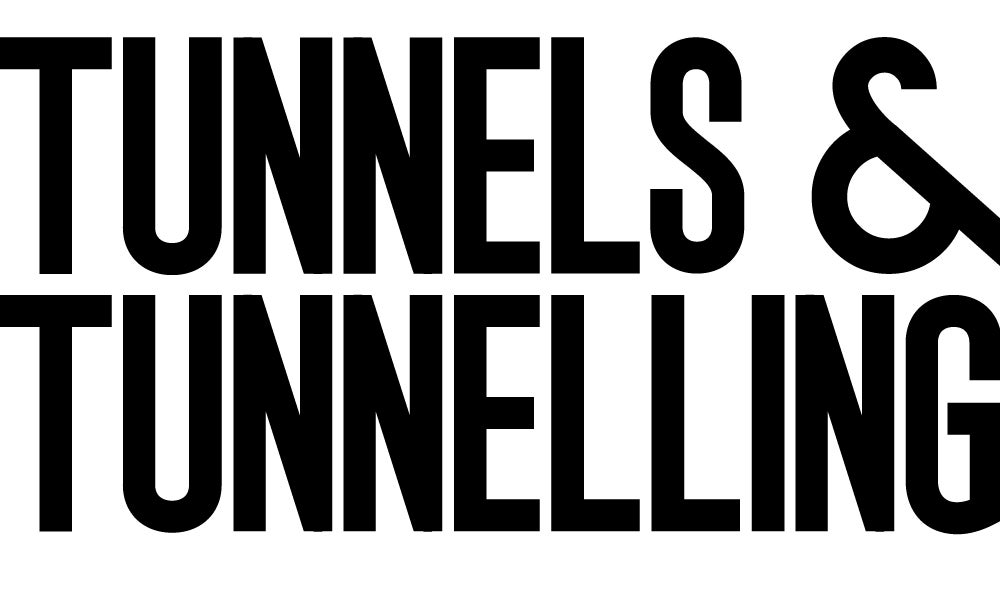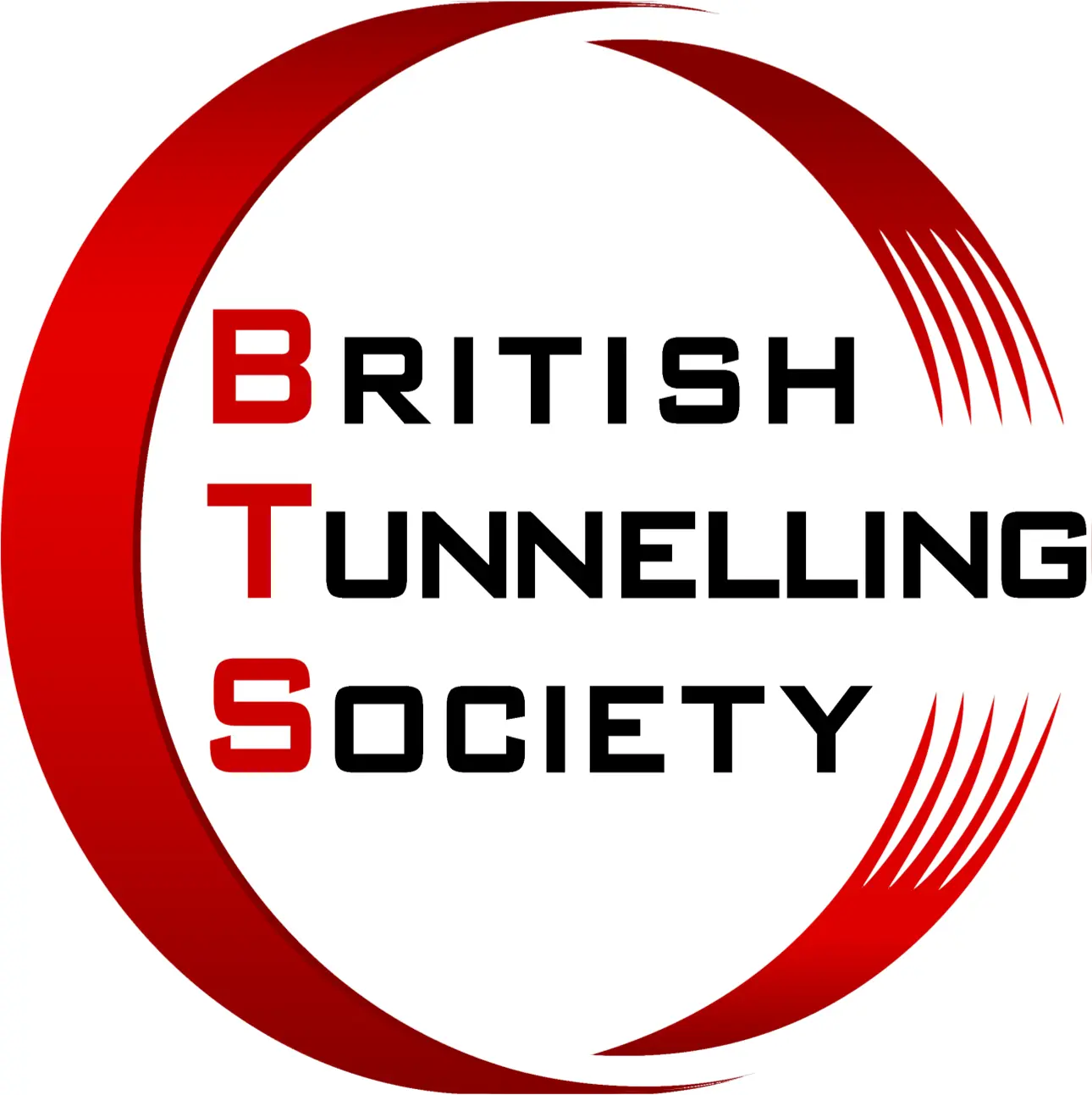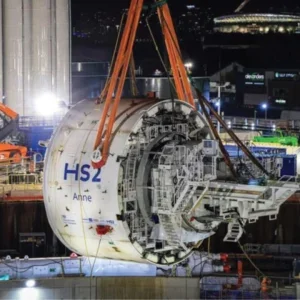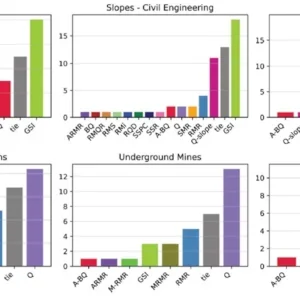The vast majority of compressed air working applications these days are for the purposes of gaining access to the front of a TBM to change cutters mid-drive. In theory the same effect of keeping the water out and face stabilisation for miners’ safety could be achieved by grouting or dewatering principally, but many contractors still find the compressed air option more convenient.
Nevertheless, compressed air working has always had to be employed with caution due to the potential health hazards and the possibilities of ‘blow outs’. The dangers of the ‘bends’ and bone necrosis (dysbaric osteonecrosis) are relatively well known, but there are other less obvious health difficulties. Tony Ridley of Tony Ridley Hyperbaric Associates also lists different forms of decompression illness (acute pain and neurological problems) and other barotraumas (pressure injury) such as to the ears and sinus cavities. These medical problems have been tackled over the years by improved specialist medical knowledge to determine optimum working conditions, and better control of decompression.
The more traditional uses for compressed air atmospheres such as excavating by ‘manual’ or mechanical means are now rarely practiced. Peter Remnant of hyperbaric equipment suppliers Specialist Plant maintains, “Compressed air operations for open face excavations in a shield are pretty unlikely to crop up again. The main needs are retooling TBMs or possibly in dealing with obstructions.”
Lovat TBMs in the Lea Valley project in east London were equipped with compressed air facilities for contractor Murphy in case they encountered reinforced concrete piles, despite changes to the route.
One activity in which compressed air working may be needed is at the junctions between tunnel and shaft in wet ground.
Compressed air can be used along with other groundwater treatment methods such as shields, permeation and jet grouting, and groundwater lowering.
Groundwater lowering is believed to have been first used with compressed air working in tunnels in Antwerp in 1970, with the main purpose of reducing the groundwater pressure on TBM tail-seals to below one bar. Since then it has often been used to reduce the groundwater pressure on the excavation, and so lower the counterbalancing pressure required for compressed air.
Statistics
Apart from general knowledge of the detrimental health effects of improper compressed air working, such as the ‘bends’ and bone necrosis, procedures of care for miners working in these conditions are based chiefly on medical monitoring and statistical evidence. In the UK the statistics are in two main groups: The ‘Newcastle’ group of tunnellers and other compressed workers, chiefly in the north-east of England, until 1986; and a second group covering activity since 1994 established by Dr Donald Lamont, of the UK’s Health & Safety Executive (HSE), known as the HSE data. Lamont has recently been awarded a PhD by Aston University for the study of compressed air data entitled “Decompression illness and its regulations in contemporary UK tunnelling – an engineering perspective”. The database contains information from 32 contracts involving around 2300 men with around 120,000 exposures. There were 400 cases of decompression illness since 1984.
It is also appropriate to mention here the passing away of Val Hemplemann, former chair of the British Tunnelling Society’s Compressed Air Working Group (CWAG), who, through the Royal Navy, pioneered deep diving technology and worked to overcome incidents of ‘the bends’ from 1968 to 1982 as superintendent of the Royal Navy Physiological Laboratory. Of direct relevance to tunnelling, he wrote the Blackpool Tables in 1966. This became an international standard work, still used by some today. The tables established a more systematic approach that reduced incidence of decompression sickness, which had been higher than that for divers. As a result many lives have been saved.
Today the CWAG, chaired by Roy Slocombe of Herrenknecht, continues its work in areas that should improve compressed air working procedures. A team of practitioners and researchers led by the Institute of Occupational Medicine has consulted the Group. This is examining the use of Doppler technology for real-time monitoring of bloodstream bubble occurrence to assess the efficiency of decompression procedures in tunnelling, aimed at replacing retrospective studies. It is understood that the preferred monitoring period of each worker can take up to three hours, so there are obvious potential problems with scheduling such monitoring, and perhaps a tendency to try and avoid it. The actions to take if the results are negative are not yet clear. Trained monitoring operatives are required and with an uneven workload, they may need other occupations or be itinerant. This study is an international first for this technology, and results are expected this year.
Another approach to monitoring is the use of magnetic resonance imaging to detect osteonecrosis, but there has been no agreement on how to progress with this.
Alternative monitoring procedures are under development to improve the accuracy of predicting the effects of compressed air working and recovery. Problems with them, even under strictly controlled conditions, are the practicality for site conditions, and determining the effect of different worker body forms and life experience. Added to this, the current intensity of monitoring may produce expected statistical results compared to old practices when miners may ‘escape’ at the end of shifts without being checked. Jim Buchanan, a member of the BTS Compressed Air Working Group and former chief tunnelling engineer of Sir Robert McAlpine commented: “It is difficult to determine a norm these days when there is so little compressed air exposure work going on. There were only nine men in these experiments!”
Another medical care initiative being discussed within the CWAG is the production of an ‘atlas’ of x-rays of osteonecrosis conditions to aid recognition of the associated bone lesions. Dr Philip Griffiths compiled the original in the mid ‘70s for limited issue. Modern high-resolution digital reproduction has been used to produce illustrations on DVD with distribution in a form to be finalised.
Oxygen decompression
The use of oxygen-rich atmospheres in the decompression chambers used by workers after underground construction has long been practiced in Europe. France and Germany are believed to have the most experience, despite the lack of a comprehensive database. But it was not until 2001 that regulations were introduced in the UK for correct use of oxygen in decompression. The benefit of oxygen is that it assists decompression by providing a greater diffusion gradient for the elimination of nitrogen. The latter is the gas that can potentially cause decompression illness. Not only should its correct use reduce the incidence of illness, it can also reduce the required decompression time compared to ‘air only’ schedules. The procedures were introduced by the HSE with the aim of reducing the incidence of decompression sickness. According to the Donald Lamont, this has been achieved to an estimated factor of ten. The HSE spent a reported US$1-2M in support of the introduction of oxygen decompression.
However, the domestic improvement in compressed air use in the UK has been difficult to prove since only one major project, the Channel Tunnel Rail Link’s ‘Thames Tunnels’ Contract 320, has used it. Lamont says that he needs records of 10,000 compressed air exposures to provide fully valid statistical proof, but, due to the current low use of compressed air tunnelling, only 320-330 exposure records are available.
A tricky issue being tackled by the CWAG and others is the provision of oxygen rebreathing self-rescuers suitable for compressed air atmospheres, as they can potentially create problems with oxygen toxicity. This is made worse by high respiratory stress due to, for example, trying to escape from a fire. The HSE has funded work to form a suitable design but discussions are still underway to arrange manufacture.
However, Ridley does not think that there is such a big problem, although if funding for development were to be available, it would be correct to remove it. “High respiratory stress conditions are unlikely to be induced in escape from the confines of a TBM head. They would be more associated with traditional compressed air work within large sections of pressurised tunnel. I don’t view this as a huge issue for TBM intervention provided we are aware of it.”
Expert resources
Since the knowledge and resource base for compressed air working underground is less widespread these days, specialists naturally become more important. While there is still something of a ‘feast or famine’ characteristic to the market, those that can supply the tunnelling industry’s requirements have found frequent work all around the world. Tony Ridley Hyperbaric Associates, based in the east of England, is one such centre of expertise, serving offshore requirements as well the underground.
There are concerns amongst some international practitioners that standards of equipment and procedures are not uniform across the world. Tony Ridley comments: “To some degree standards, particularly for equipment, are already common. The problem is that not all choose to observe the standards; sometimes depending on location and sometimes on normal practice within a country. What is standard practice in the UK is not necessarily observed in Europe or other parts of the world. In terms of hyperbaric operating procedures it would be very difficult to adopt and police set standards for similar reasons. There also needs to be some ‘leeway’ to establish best practice for specific projects in particular locations relevant to the operational regimes that they can realistically safely support. Therefore I think there is a big role for specialist companies who can bring a wide range of hyperbaric tunnelling and safety knowledge to a project, regardless of the legislation it may or may not be under.”
Skills
As with many other construction skills, there can still be a shortage of the necessary skills and experience for compressed air working. According to Ridley this is particularly so for TBM intervention work for cutter changing. “There is a definite shortage of people with superior skills in hyperbaric practice,” he says. “You need TBM experience and safe working to change tools. Divers are often called in who have no TBM experience and so safety and efficiency can suffer. We would prefer to have experienced miners trained up in hyperbaric practice.”
As for formal qualifications as a check on competence, the UK requires tunnelling hyperbaric supervisors to be qualified to the same level as offshore diving life-support personnel. This includes a formal examination and minimum periods of experience, taking about four years to reach the highest standard. Ridley maintains that additional training is required for tunnelling and TBM safety. “However, without doubt,” he states, “the UK legislation carries the highest basic requirements in the world.”
The spread of good practice in compressed air working around the world may not always conform to stereotypes. Responsible contractors and the importance of recognised good practice from other areas are more reliable indicators. For example, in construction of the Sao Paulo Metro, Brazil, Odebrecht, a well-established contractor in South America, has utilised the skills of SELI of Italy as well as input from Tony Ridley Hyperbaric Associates.
High pressures
London’s Thames Tideway Tunnel for Thames Water has now been given the go-ahead, and the use of compressed air atmosphere for TBM interventions is under consideration, although the chalk ground is highly fractured. The depths of working involved would necessitate high pressures (around 6.5 bar) and maybe ‘saturation’ working, but there appears to be little prospect of this happening in the UK, although higher pressures have been used recently elsewhere internationally. Roy Slocombe commented that, although recent press reports deem the high pressures to be ‘news worthy’, higher pressure working is already in use in projects such as the Hallandsås project, in Sweden, (design for 12-13 bar and up to 10 bar actually used).
There is substantial expertise based in Germany and the Netherlands aimed mainly at diving for offshore installations.
Nordseetaucher is perhaps best known in the tunnelling industry for its work on cutter changes and recovery operations on the Herrenknecht TBMs used on the Westerschelde tunnels, in the Netherlands, in August 2001, but have also carried out many TBM interventions since, including those on the Wesertunnel, in Germany, and Line 9 of the Barcelona Metro, Spain. The experts were also involved in the first application of oxygen decompression intervention for CTRL’s Thames Tunnel, in the UK, for the Hochtief/Murphy JV.
Future reluctance?
Although other methods of improving safe access for interventions at the face of TBMs have been tried, they too have had their problems. Interventions under relatively low compressed air pressures are fairly commonplace, allowing experience and skills to build up. However, in other applications and different geographical areas, this has not been the case.
Despite a wealth of older knowledge and experience, and procedures with which the HSE is happy, there is little compressed air working activity in the UK for example. In one instance the client, Thames Water, had to be persuaded that compressed air working with a shaft air lock was the best option to form a secure tunnel connection safely for the north London, Enfield Relief Sewer. The contractor had attempted solutions by jet grouting and dewatering, which were largely unsuccessful in sandy ground. However, the use of compressed air working at only 0.5-0.7 bar forced groundwater away from the excavation so that a substantial length of heading could be excavated as well as forming the junction.
Of course, objections to the use of compressed air working may well be valid for a specific tunnelling project, if not based on misconceptions. The introduction of oxygen decompression brought with it new regulations, which some contractors feel are too onerous, and cautious clients have not helped. “People have taken fright of the new regulations,” says Specialist Plant’s Peter Remnant. “But, compressed air equipment can be used without huge expense. There is a distinct lack of bidding activity for TBM air-locks,” he reports, “therefore the emphasis is on rental equipment.”
Specialist Plant supplies tunnelling and construction projects with standard and specially engineered equipment for purchase or rental. Hyperbaric tunnelling systems are a speciality including air locks, compressed air plant and bulkheads. Medical decompression chambers and oxygen systems are included in the rental fleet.
Projects supplied recently by Specialist Plant include the Lovat TBM air-locks and equipment for Amec’s Docklands Light Railway (DLR) Extension work, and contingency equipment and bulkheads for Murphy in the Lea Valley cable tunnels, both in London, projects in New Zealand for McConnell Dowell, and also the Dubai Metro, in the UAE. Currently the firm is mobilising for 4.1m and 2.5m diameter tunnels for Belfast, Northern Ireland under new national compressed air regulations.
Conclusion
Many practitioners fear the demise of compressed air working, resulting in the loss of a valuable technology that still has its place in tunnelling. The lack of numbers involved has resulted in difficulties in accurate monitoring under modern conditions, and past perceptions of compressed air working are today rarely valid. Whilst contractors and clients can hardly be forced to use compressed air underground, it seems there still needs to be a knowledge base for the future with adequate experience. Seems like a fruitful ground for the adaptable specialist!
A worker breathing oxygen during decompression Entering the air lock of the Herrenknecht ‘Trude’ TBM, on the 4th Elbe Tunnel, in Germany. At least two personnel trained in first aid in compressed air working are necessary Entering the air lock of the Herrenknecht ‘Trude’ TBM Decompression procedures in the Herrenknecht ‘Trude’ TBM used for the 4th Elbe Tunnel crossing, in Germany Decompression procedures in the Herrenknecht ‘Trude’ TBM Checking air-lock instrumentation Checking air-lock instrumentation Further Reading
1. Health & Safety Executive, Construction (Design and Management) Regulations 1994
2. Health & Safety Executive, Construction (Health, Safety and Welfare) Regulations 1996
3. Health & Safety Executive, Work In Compressed Air Regulations 1996
4. Health & Safety Executive, Guidance on Regulations (as above) ISBN 0-7176-1120-5
5. TG Anthony & MJ Woolcott. Generic modifications of compressed oxygen self-rescuers for use in compressed air tunnels at pressures of 0.0 to 3.5 bar gauge (U)
6. BSI, European Standard EN12110:2002 Tunnelling machines, Air locks, Safety requirements. Institution of Civil Engineers Proceedings ‘Civil Engineering’, Study of decompression illness incidence, November 2006
7. T Thomas, 2007. “DLR drives safely under the Thamesâ€. T&T International April 2007 p16






